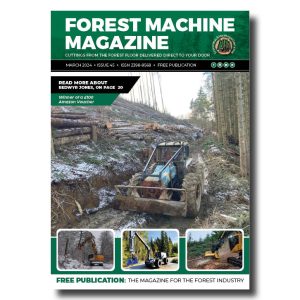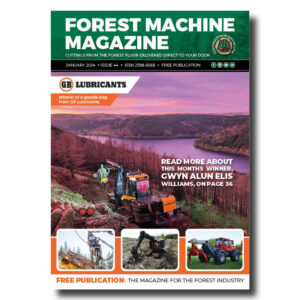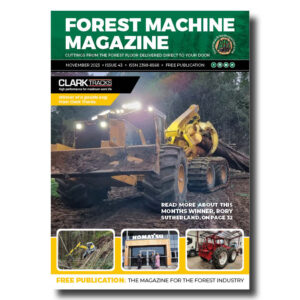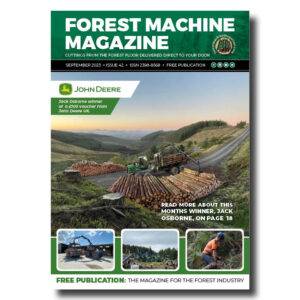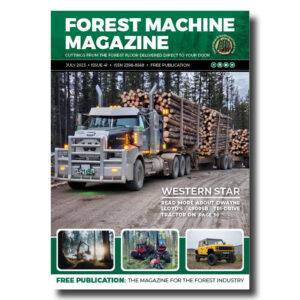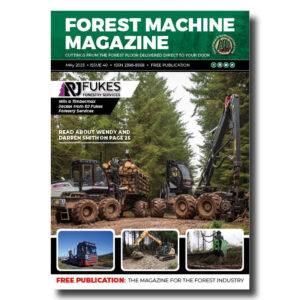Designed for strength, sustainability, and style—InventWood’s Superwood may transform construction, cladding, and even battlefield design.
”A new type of engineered wood, Superwood, developed by the US-based company InventWood, has the potential to revolutionize building construction by making structures bullet-resistant. This product began full production earlier this year. It is a heavily modified timber that is claimed to be “stronger than steel.”

-
That’s a remarkable amount of work hours for a single machine, the Norcar 600 owned by Erkki Rinne is taken well care of, it even has the original Diesel engine.
-
Kieran Anders is a forestry contractor working in the lake district. His work involves hand cutting and extracting timber using a skidder and tractor-trailer forwarder.
-
It is not possible to eliminate chain shot, but there are simple steps that can be taken to reduce the risk.
-
Arwel takes great pride in the fact that the mill has no waste whatsoever, “the peelings are used for children’s playgrounds, gardens and for farm animals in barns in the winter and the sawdust has multiple uses in gardens and farms as well.
-
Timber hauliers need to encourage young blood in, and also look after the hauliers we have, we need make the sector a safe and positive place to work.
FIND US ON
Related Posts
In laboratory testing, researchers utilized a gas gun to launch a bullet-like projectile at thin wood samples, including an early iteration of Superwood. While the projectile readily penetrated natural timber, it encountered resistance when aimed at the modified variant. Alex Lau, co-founder and executive chairman of InventWood, articulated the potential for a clad structure using this new type of modified wood, suggesting that it could resist ballistic impacts. He indicated that such a product might be applicable in military contexts, particularly for battlefield shelters, although he acknowledged the absence of tests involving bomb impacts.
As the construction industry endeavors to decarbonize, traditional materials such as concrete—often associated with considerable greenhouse gas emissions—are receiving heightened scrutiny. Although timber-based construction is regarded as a more sustainable alternative, natural wood presents certain limitations: it can deteriorate when subjected to moisture or insect activity and frequently lacks the requisite strength for demanding structural applications. Engineered wood products are emerging as solutions to these challenges. Lau elucidated that Superwood is produced by chemically removing lignin, a polymer present in wood, followed by compressing the timber to reduce its volume by 80 percent. He described the process as akin to ‘massaging’ the wood, effectively expelling air and imperfections. This method enhances the material’s structural integrity by generating additional hydrogen bonds while maintaining the wood’s natural grain
InventWood has dedicated several years to refining its manufacturing process. What previously required more than a week can now be accomplished in a matter of hours. The company currently utilizes poplar trees but is investigating bamboo as a potential alternative feedstock. “We can cultivate suitable bamboo feedstock in approximately three to four years,” Lau informed BBC Technology Reporter Chris Baraniuk. “It represents a highly efficient method for sequestering carbon from the atmosphere.”
Superwood contributes to an expanding portfolio of engineered timber products that are advancing the capabilities of timber-based construction. For instance, glue-laminated timber (glulam) involves laminating layers of wood with aligned grain to produce robust, moisture-resistant beams. Cross-laminated timber (CLT) arranges layers with alternating grain directions to create panels utilized in walls and floors. A study published in June indicated that employing CLT instead of concrete for the construction of a community center could reduce associated carbon emissions by nearly 10%.
Lau stated that Superwood is not designed to compete directly with products such as CLT or glulam. Rather, it has the potential to function as a structurally sound and visually appealing finishing layer or as resilient external cladding. Morwenna Spear, a research fellow at Bangor University’s BioComposites Centre, characterized the technology as “promising”; however, she emphasized the importance of ensuring that external wood in climates like that of the UK can endure frequent wet-dry cycles. “I would require some data from them to support that assertion,” she commented.
Numerous companies are making significant advancements in the engineered wood sector. The German firm Pollmeier has introduced BauBuche, a laminated veneer lumber derived from beech, a species that is not traditionally utilized in construction. According to Michael Ramage, the director of the Centre for Natural Material Innovation at the University of Cambridge, processing beech into veneers enables its structural application to a much greater extent. Additionally, the Australian company 3RT employs thin veneer sheets sourced from low-value trees or pulp logs to mimic the structure and density of high-value hardwoods, which are commonly featured in window frames, kitchen cabinetry, furniture, and staircase treads. Spear noted that the increasing diversity of engineered wood products provides architects and designers with enhanced flexibility, suggesting that these innovative materials should be viewed as “pseudo-species,” thereby expanding the available options for design professionals.
Despite this momentum, several challenges persist within the field. Ramage highlighted that financial and regulatory considerations continue to favor conventional materials, raising pertinent questions such as whether mortgage rates for engineered wood structures are equivalent to those for concrete buildings, or whether insurance costs align accordingly. Nevertheless, he supports the broader adoption of wood products, citing their potential for carbon storage. He acknowledged the ongoing necessity for concrete in foundational applications. Additionally, concerns regarding fire resistance remain prominent, particularly in light of recent catastrophic wildfires, such as those that affected Los Angeles in January. Lau reported that Superwood has successfully undergone fire-resistance testing and demonstrated resilience against wood-eating insects. Although this material presents more challenges in terms of workability compared to natural timber, it can be processed using carbide or diamond-tipped tools.
Spear emphasized the significant importance of timber recycling in conjunction with the rise of engineered wood products. Recent research conducted in the United Kingdom has demonstrated that waste wood derived from deconstructed buildings can be effectively transformed into new materials, such as cross-laminated timber (CLT) panels. She further noted that recycled wood is already prevalent in a variety of everyday products. “A substantial portion of our furniture is constructed from particleboard, a considerable amount of which originates from recycled timber,” she stated.
Sign up for our free monthly newsletter here
Contact forestmachinemagazine@mail.com to get your products and services seen on the world’s largest professional forestry online news network.
#homeoflogging #writtenbyloggersforloggers #loggingallovertheworld
Written by loggers for loggers and dedicated solely to the equipment used in forestry operations.



